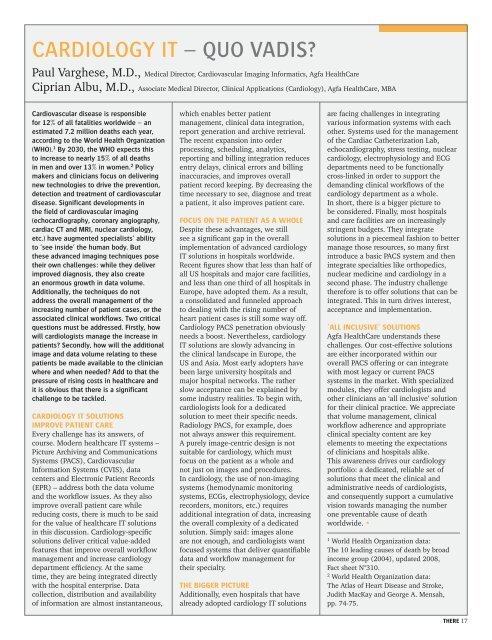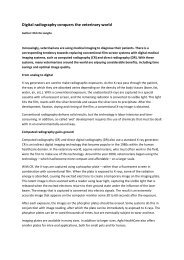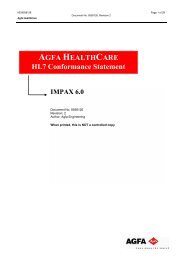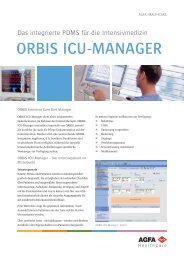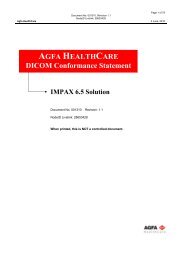Edition 4 - Agfa HealthCare
Edition 4 - Agfa HealthCare
Edition 4 - Agfa HealthCare
Create successful ePaper yourself
Turn your PDF publications into a flip-book with our unique Google optimized e-Paper software.
Cardiology IT – Quo Vadis<br />
Paul Varghese, M.D., Medical Director, Cardiovascular Imaging Informatics, <strong>Agfa</strong> <strong>HealthCare</strong><br />
Ciprian Albu, M.D., Associate Medical Director, Clinical Applications (Cardiology), <strong>Agfa</strong> <strong>HealthCare</strong>, MBA<br />
Cardiovascular disease is responsible<br />
for 12% of all fatalities worldwide – an<br />
estimated 7.2 million deaths each year,<br />
according to the World Health Organization<br />
(WHO). 1 By 2030, the WHO expects this<br />
to increase to nearly 15% of all deaths<br />
in men and over 13% in women. 2 Policy<br />
makers and clinicians focus on delivering<br />
new technologies to drive the prevention,<br />
detection and treatment of cardiovascular<br />
disease. Significant developments in<br />
the field of cardiovascular imaging<br />
(echocardiography, coronary angiography,<br />
cardiac CT and MRI, nuclear cardiology,<br />
etc.) have augmented specialists’ ability<br />
to ‘see inside’ the human body. But<br />
these advanced imaging techniques pose<br />
their own challenges: while they deliver<br />
improved diagnosis, they also create<br />
an enormous growth in data volume.<br />
Additionally, the techniques do not<br />
address the overall management of the<br />
increasing number of patient cases, or the<br />
associated clinical workflows. Two critical<br />
questions must be addressed. Firstly, how<br />
will cardiologists manage the increase in<br />
patients Secondly, how will the additional<br />
image and data volume relating to these<br />
patients be made available to the clinician<br />
where and when needed Add to that the<br />
pressure of rising costs in healthcare and<br />
it is obvious that there is a significant<br />
challenge to be tackled.<br />
Cardiology IT solutions<br />
improve patient care<br />
Every challenge has its answers, of<br />
course. Modern healthcare IT systems –<br />
Picture Archiving and Communications<br />
Systems (PACS), Cardiovascular<br />
Information Systems (CVIS), data<br />
centers and Electronic Patient Records<br />
(EPR) – address both the data volume<br />
and the workflow issues. As they also<br />
improve overall patient care while<br />
reducing costs, there is much to be said<br />
for the value of healthcare IT solutions<br />
in this discussion. Cardiology-specific<br />
solutions deliver critical value-added<br />
features that improve overall workflow<br />
management and increase cardiology<br />
department efficiency. At the same<br />
time, they are being integrated directly<br />
with the hospital enterprise. Data<br />
collection, distribution and availability<br />
of information are almost instantaneous,<br />
which enables better patient<br />
management, clinical data integration,<br />
report generation and archive retrieval.<br />
The recent expansion into order<br />
processing, scheduling, analytics,<br />
reporting and billing integration reduces<br />
entry delays, clinical errors and billing<br />
inaccuracies, and improves overall<br />
patient record keeping. By decreasing the<br />
time necessary to see, diagnose and treat<br />
a patient, it also improves patient care.<br />
Focus on the patient as a whole<br />
Despite these advantages, we still<br />
see a significant gap in the overall<br />
implementation of advanced cardiology<br />
IT solutions in hospitals worldwide.<br />
Recent figures show that less than half of<br />
all US hospitals and major care facilities,<br />
and less than one third of all hospitals in<br />
Europe, have adopted them. As a result,<br />
a consolidated and funneled approach<br />
to dealing with the rising number of<br />
heart patient cases is still some way off.<br />
Cardiology PACS penetration obviously<br />
needs a boost. Nevertheless, cardiology<br />
IT solutions are slowly advancing in<br />
the clinical landscape in Europe, the<br />
US and Asia. Most early adopters have<br />
been large university hospitals and<br />
major hospital networks. The rather<br />
slow acceptance can be explained by<br />
some industry realities. To begin with,<br />
cardiologists look for a dedicated<br />
solution to meet their specific needs.<br />
Radiology PACS, for example, does<br />
not always answer this requirement.<br />
A purely image-centric design is not<br />
suitable for cardiology, which must<br />
focus on the patient as a whole and<br />
not just on images and procedures.<br />
In cardiology, the use of non-imaging<br />
systems (hemodynamic monitoring<br />
systems, ECGs, electrophysiology, device<br />
recorders, monitors, etc.) requires<br />
additional integration of data, increasing<br />
the overall complexity of a dedicated<br />
solution. Simply said: images alone<br />
are not enough, and cardiologists want<br />
focused systems that deliver quantifiable<br />
data and workflow management for<br />
their specialty.<br />
The bigger picture<br />
Additionally, even hospitals that have<br />
already adopted cardiology IT solutions<br />
are facing challenges in integrating<br />
various information systems with each<br />
other. Systems used for the management<br />
of the Cardiac Catheterization Lab,<br />
echocardiography, stress testing, nuclear<br />
cardiology, electrophysiology and ECG<br />
departments need to be functionally<br />
cross-linked in order to support the<br />
demanding clinical workflows of the<br />
cardiology department as a whole.<br />
In short, there is a bigger picture to<br />
be considered. Finally, most hospitals<br />
and care facilities are on increasingly<br />
stringent budgets. They integrate<br />
solutions in a piecemeal fashion to better<br />
manage those resources, so many first<br />
introduce a basic PACS system and then<br />
integrate specialties like orthopedics,<br />
nuclear medicine and cardiology in a<br />
second phase. The industry challenge<br />
therefore is to offer solutions that can be<br />
integrated. This in turn drives interest,<br />
acceptance and implementation.<br />
‘all inclusive’ solutions<br />
<strong>Agfa</strong> <strong>HealthCare</strong> understands these<br />
challenges. Our cost-effective solutions<br />
are either incorporated within our<br />
overall PACS offering or can integrate<br />
with most legacy or current PACS<br />
systems in the market. With specialized<br />
modules, they offer cardiologists and<br />
other clinicians an ‘all inclusive’ solution<br />
for their clinical practice. We appreciate<br />
that volume management, clinical<br />
workflow adherence and appropriate<br />
clinical specialty content are key<br />
elements to meeting the expectations<br />
of clinicians and hospitals alike.<br />
This awareness drives our cardiology<br />
portfolio: a dedicated, reliable set of<br />
solutions that meet the clinical and<br />
administrative needs of cardiologists,<br />
and consequently support a cumulative<br />
vision towards managing the number<br />
one preventable cause of death<br />
worldwide. •<br />
1<br />
World Health Organization data:<br />
The 10 leading causes of death by broad<br />
income group (2004), updated 2008,<br />
Fact sheet N°310.<br />
2<br />
World Health Organization data:<br />
The Atlas of Heart Disease and Stroke,<br />
Judith MacKay and George A. Mensah,<br />
pp. 74-75.<br />
THERE 17


